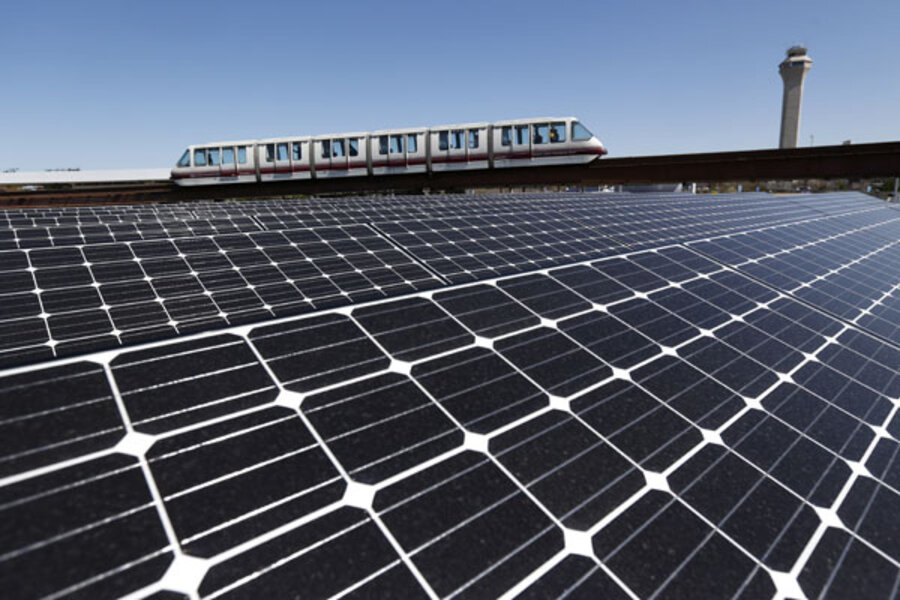Solar power breakthrough hints at cheaper panels for more roofs
Loading...
Efforts to bring a new class of solar cells to market may have received a significant boost from a new recipe for making the cells, developed independently by two teams of scientists.
The recipe involves solar cells that use the mineral perovskite as a key ingredient. Until now, researchers had been working with a semiconductor built around a blend of lead and perovskite. The new recipe blends tin with perovskite, an approach that uses cheaper materials than many of today's generation of solar cells and carries far less environmental and regulatory baggage.
During the past few days, two independent groups have reported encouraging results from their initial experiments with this new tin-pervoskite solar cell.
On May 1, a team led by Oxford University researcher Henry Snaith reported producing a tin-perovskite cell that converted more than 6 percent of the sunlight it receives into electricity. A formal description of the work appeared online, published by the journal Energy and Environmental Science.
Three days later, a team led by Northwestern University researchers Robert Chang and Mercouri Kanatzidis reported similar results at a slightly lower efficiency – 5.73 percent – in the journal Nature Photonics.
These figures are low compared with the top performing photovoltaic cells made today, which boast efficiencies of up to 35 percent. But these high-efficiency cells are expensive to produce and tend to be used for the most demanding applications, such as solar panels for satellites. Even lower-cost versions still require expensive, energy-hungry machines in clean-room environments to make them.
The perovskite blends require not much more than bench-top, wet-chemistry techniques that are well within the industry's ability to use, researchers say.
Scientists at the National Renewable Energy Laboratory have suggested that the maximum theoretical efficiency individual perovskite cells can achieve is around 31 percent, or higher if the cells are stacked together to form multi-junction cells.
So far, the lead-perovskite predecessors to these new solar cells have reached efficiencies of up to 15 percent.
But "I don't think we have to go that far," says Northwestern 's University's Dr. Kanatzidis. As long as efficiencies top 10 percent, the tin-perovskite recipe "is quite viable" commercially. At around 6 percent, these new cells are within hailing distance of that goal.
Another potential contributor to the tin-perovskite solar cells' lower cost is the ability of a single cell to operate effectively over a broader range of visible wavelengths than cells currently in use. To achieve the same effective "bandwidth," today's cells have to be stacked, with each layer sensitive to a particular portion of visible wavelengths.
The prospect of ever-cheaper solar panels to generate electricity makes electric utilities nervous. Beyond the benefits solar energy can provide in reducing the climate-warming greenhouse gases that burning coal and natural gas emit, wider adoption of photovoltaic technology for homes and businesses threatens to serve as the firecracker tucked into the utility industry's business model. That model relies on large capital-intensive power plants to deliver enough electricity to meet peak demand, even as solar installations feed unused electricity into an interlinked grid.
Last year, the Edison Electric Institute published a report on so-called disruptive challenges to utilities and the way they structure their rates. The report singled out the spread of photovoltaic technologies as a key threat, one whose effect has been intensifying. One reason: The highest demand for electricity comes during the day, precisely when increasing numbers of distributed "solar power plants" nationwide would be getting the most sunlight.
To take advantage of that sunlight, the new cells take a layer-cake approach.
A top layer of electrically conducting glass receives the sunlight, followed by a thin layer of titanium dioxide, which serves as one of the cell's two connecting points, or electrodes. Next comes the tin-perovskite semiconductor, which absorbs the sunlight. The teams then applied a chemical to the underside of the semiconductor. This facilitates the buildup of an electrical charge between the electrode near the top of the cell and the final layer, another electrode, at the bottom of the cell.
The process of adding the semiconductor to a cell and adding the so-called transport layer between the semiconductor and the final electrode must be conducted in a glove box filled with nitrogen gas. The oxygen in ambient air can destroy the semiconductor. But once the transport layer is added, the rest of the cell is ready for outside-the-box assembly.
Indeed, the whole effort to explore the use of perovskites represents some outside-the-box thinking, Northwestern's Kanatzidis says. Within the photovoltaic research community, the mineral hadn't been given much thought. But once its usefulness became apparent, labs all over the world began to work with it.
Its potential for solar cells was first uncovered in 2009 by researchers in Japan – its ability to absorb light was deemed too inefficient to merit further exploration, researchers say. By 2011, however, researchers began to see glimmers of perovskite's potential. Since 2009, efficiency gains have been taking place at a far faster clip than those for conventional solar-cell semiconductors, which have been steadily improving over decades.
Even now, "we don't understand everything about it," says Kanatzidis of the new recipe. Still, with no theoretical limit to reaching an efficiency level comparable to today's top-tier solar cells, researchers are focusing on ways to improve what several say is likely to represent a breakthrough in solar-cell technology.






